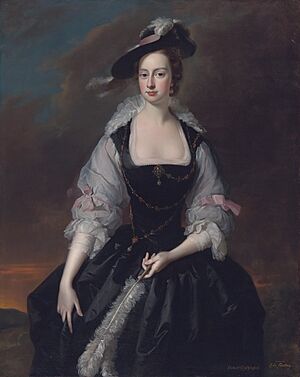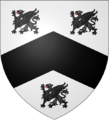William Courtenay, 1st Viscount Courtenay facts for kids
William Courtenay, 1st Viscount Courtenay (born February 11, 1709 – died May 16, 1762), was an important British nobleman. He was also considered the 7th Earl of Devon by right. He was the son of William Courtenay, who was the 6th Earl of Devon and 2nd Baronet Courtenay, and Lady Anne Bertie.
Contents
Life and Education
Sir William Courtenay went to Westminster School, which is a famous school. He then studied at Magdalen College at Oxford University. In 1731, he earned a Master of Arts degree.
On October 10, 1735, he inherited the title of 3rd Baronet Courtenay. He also became the 7th Earl of Devon by right. In 1739, Magdalen College gave him an honorary degree called Doctor of Civil Law.
He served as a Member of Parliament (MP) for Honiton from 1734 to 1741. An MP is someone elected to represent people in the government. He was part of the Tory political group. Later, he was an MP for Devon from 1741 until May 6, 1762. On that day, he was given the new title of 1st Viscount Courtenay of Powderham Castle. A Viscount is another type of noble title, a step below an Earl.
Marriage and Children

On April 2, 1741, William Courtenay married Lady Frances Finch. She was the daughter of Heneage Finch, 2nd Earl of Aylesford. Lady Frances passed away in 1761.
They had three children:
- William Courtenay, 2nd Viscount Courtenay (1742 - 1788)
- The Hon. Charlotte Courtenay (died 1826), who married Alexander Wedderburn, 1st Earl of Rosslyn
- The Hon. Frances Courtenay (died 1828), who married Sir John Wrottesley, 8th Baronet
Death and Burial
William Courtenay was buried on May 31, 1762. His burial took place in Powderham, a place in Devon, England.
Homes and Estates
William Courtenay had several homes in Devon. His main family home was Powderham Castle, which he changed and improved a lot. He also owned Forde House in Wolborough, near Newton Abbot.
His home in the city of Exeter is now the Devon and Exeter Institution. It is located at 7 Cathedral Close, right by the Cathedral Green. This building was once also home to Sir William Waller, a general from a long time ago. Parts of Waller's original building are still there at the back. The old main hall and kitchen were taken down in 1813. Libraries now stand in their place.
In one of the back rooms, there is a special carved wooden fireplace decoration from around 1750. It has two painted pictures. One picture shows the family symbols of the 1st Viscount Courtenay mixed with the symbols of his wife's family, the Finches.
Images for kids
-
This is a carved wooden decoration above a fireplace from William Courtenay's home in Exeter. It shows his family symbols mixed with his wife's family symbols. The left side shows the symbols of William Courtenay, 1st Viscount Courtenay, combined with those of his wife's family, Finch. The animal on the left is a griffin from the Finch family, and the animal on the right is a boar from the Courtenay family. The Courtenay family motto is below: Ubi lapsus quid feci (which means "Where did I slip what have I done"). The picture on the right shows the symbols of Bishop Peter Courtenay (1432–1492), who was also from the Powderham family. His symbols are combined with those of the See of Winchester (a church area). The whole picture is surrounded by the symbol of the Order of the Garter, a special knightly order. The animals supporting his symbols are a dolphin and a boar, both from the Courtenay family. The motto below is: Quod verum tutum (meaning "What is true is safe").
Sources
Burkes Peerage
| Parliament of Great Britain (1707–1800) | ||
|---|---|---|
| Preceded by Sir William Yonge |
Member of Parliament for Honiton 1734–1741 With: Sir William Yonge |
Succeeded by Sir William Yonge |
| Preceded by Henry Rolle |
Member of Parliament for Devon 1741–1762 With: Theophilus Fortescue 1741–1746 Sir Thomas Dyke Acland 1746–1747 Sir Richard Bampfylde 1747–1762 |
Succeeded by Sir Richard Bampfylde |
| Peerage of England | ||
| Preceded by William Courtenay |
Earl of Devon de jure 1735–1762 |
Succeeded by William Courtenay |
| Peerage of Great Britain | ||
| New creation | Viscount Courtenay of Powderham 1762 |
Succeeded by William Courtenay |
| Baronetage of England | ||
| Preceded by William Courtenay |
Baronet 1735–1762 |
Succeeded by William Courtenay |



